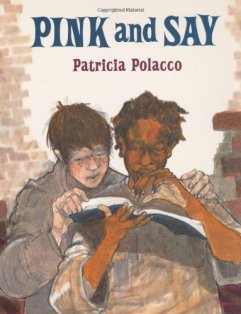 Palacio, R.J. (2012). Wonder. New York, NY: Alfred A. Knopf.
Palacio, R.J. (2012). Wonder. New York, NY: Alfred A. Knopf.
Summary: August, or Auggie, was born with a rare disorder that causes him to look different and as a result, he has been homeschooled since kindergarten. Now that he is entering middle school, it has been decided that he should attend a real school. While at school, Auggie has to deal with not only the prejudices children have because of his disorder but also the issues that come with growing up and being in middle school.
Via, Auggie’s older sister, is now in high school and has decided she wants to go by Olivia. She wants a new identity, one where people don’t know here as Via, the girl with the deformed brother. She has lost her best friends with high school, has become part of school theater, has a new boyfriend, and is suddenly fighting with her mother. Why can’t anyone realize that Olivia exists, too?
And then there are the various people in Auggie and Olivia’s lives. Auggie becomes acquainted with Jack Will and Summer, his two best frends and Julian, his enemy. Olivia says goodbye to Miranda, her friend since elementary school and hello to Justin, her musician boyfriend. Bringing the story together are Auggie’s and Olivia’s parents.
Impressions: When I worked at San Antonio Public Library, older tweens and younger teens were asking for this book left and right and after reading it I can see why it is so popular. What I liked most about the book was not that you learn about acceptance of people who are different than you, sure that is the major theme of the book, but that Palacio incorporated the chapters offering the perspectives of the other characters. Too often in books, and in life, we get one side of the story. As I read Auggie’s story and I got to the Bleeding Scream part, I was angry at Jack Will. But when I read his chapter, I realized that he was in middle school and felt peer pressured and ultimately said something stupid, not thinking of the consequences. We have all been there.
Review: “After being home-schooled for years, Auggie Pullman is about to start fifth grade, but he’s worried: How will he fit into middle school life when he looks so different from everyone else?
Auggie has had 27 surgeries to correct facial anomalies he was born with, but he still has a face that has earned him such cruel nicknames as Freak, Freddy Krueger, Gross-out and Lizard face. Though “his features look like they’ve been melted, like the drippings on a candle” and he’s used to people averting their eyes when they see him, he’s an engaging boy who feels pretty ordinary inside. He’s smart, funny, kind and brave, but his father says that having Auggie attend Beecher Prep would be like sending “a lamb to the slaughter.” Palacio divides the novel into eight parts, interspersing Auggie’s first-person narrative with the voices of family members and classmates, wisely expanding the story beyond Auggie’s viewpoint and demonstrating that Auggie’s arrival at school doesn’t test only him, it affects everyone in the community. Auggie may be finding his place in the world, but that world must find a way to make room for him, too.
A memorable story of kindness, courage and wonder.”
Kirkus Reviews. (2015, November 15). [Review of the book Wonder, by R.J. Palacio]. Kirkus Reviews, p. 73.
“Kids’ books about befriending somebody “different” could fill a library. But this debut novel rises to the top through its subtle shifting of focus to those who are “normal,” thereby throwing into doubt presumptions readers may have about any of the characters. Nominally, the story is about 10-year-old August, a homeschooled boy who is about to take the plunge into a private middle school. Even 27 operations later, Auggie’s face has what doctors call “anomolies”; Auggie himself calls it “my tiny, mushed-up face.” He is gentle and smart, but his mere physical presence sends the lives of a dozen people into a tailspin: his sister, his old friends, the new kids he meets, their parents, the school administrators—the list goes on and on. Palacio’s bold move is to leave Auggie’s first-person story to follow these increasingly tangential characters. This storytelling strategy is always fraught with peril because of how readers must refresh their interest level with each new section. However, much like Ilene Cooper’s similarly structured Angel in My Pocket (2011), Palacio’s novel feels not only effortless but downright graceful, and by the stand-up-and-cheer conclusion, readers will be doing just that, and feeling as if they are part of this troubled but ultimately warm-hearted community.”
Kraus, D. (2012, February 1). [Review of the book Wonder, by R.J. Palacio]. Booklist, 108(11), p. 77.
Library Uses: This is a great book to use during National Bullying Prevention Month (the STOMP Out Bullying campaign) which I see no reason libraries (or if someone was in a school library) can’t be apart of – as a community organization, we should play a role in ending bullying). Also, this is another great read for a book talk or tween book club. I can think of so many things to discuss, such as bullying, not jumping to conclusion, feelings about growing up, friendship, miscommunication.
 Cowley, J & Bishop, N. (2005). Chameleon, chameleon. New York, NY: Scholastic Press.
Cowley, J & Bishop, N. (2005). Chameleon, chameleon. New York, NY: Scholastic Press.
 Palacco, P. (1994). Pink and say. New York, NY: Babushka Inc.
Palacco, P. (1994). Pink and say. New York, NY: Babushka Inc. Lowry, L. (2006). Gossamer. Boston, MA: Houghton Mifflin Company.
Lowry, L. (2006). Gossamer. Boston, MA: Houghton Mifflin Company.  Palacio, R.J. (2012). Wonder. New York, NY: Alfred A. Knopf.
Palacio, R.J. (2012). Wonder. New York, NY: Alfred A. Knopf. Gaiman, N. (2008). The Graveyard book. New York: HarperCollins Pub.
Gaiman, N. (2008). The Graveyard book. New York: HarperCollins Pub. 
